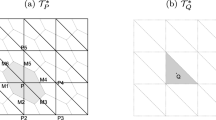Abstract
A new type of hybrid finite element formulation with fundamental solutions as internal interpolation functions, named as HFS-FEM, is presented in this paper and used for solving two dimensional heat conduction problems in single and multi-layer materials. In the proposed approach, a new variational functional is firstly constructed for the proposed HFS-FE model and the related existence of extremum is presented. Then, the assumed internal potential field constructed by the linear combination of fundamental solutions at points outside the elemental domain under consideration is used as the internal interpolation function, which analytically satisfies the governing equation within each element. As a result, the domain integrals in the variational functional formulation can be converted into the boundary integrals which can significantly simplify the calculation of the element stiffness matrix. The independent frame field is also introduced to guarantee the inter-element continuity and the stationary condition of the new variational functional is used to obtain the final stiffness equations. The proposed method inherits the advantages of the hybrid Trefftz finite element method (HT-FEM) over the conventional finite element method (FEM) and boundary element method (BEM), and avoids the difficulty in selecting appropriate terms of T-complete functions used in HT-FEM, as the fundamental solutions contain usually one term only, rather than a series containing infinitely many terms. Further, the fundamental solutions of a problem are, in general, easier to derive than the T-complete functions of that problem. Finally, several examples are presented to assess the performance of the proposed method, and the obtained numerical results show good numerical accuracy and remarkable insensitivity to mesh distortion.
Similar content being viewed by others
References
Martin, H.C. and Carey, G.F., Introduction to Finite Element Analysis: Theory and Applications. New York: McGraw-Hill Book Company, 1973.
Argyris, J.H., Dunne, P.C., Angelopoulos, T. and Bichat, B., Large natural strains and some special difficulties due to non-linearity and incompressibility in finite elements. Computer Methods in Applied Mechanics and Engineering, 1974, 4: 219–278.
Tenek, L. and Argyris, J.H., Computational aspects of the natural-mode finite element method. Communications in Numerical Methods in Engineering, 1997, 13: 705–713.
Qin, Q.H., Hybrid-trefftz finite-element method for reissner plates on an elastic-foundation. Computer Methods in Applied Mechanics and Engineering, 1995, 122: 379–392.
Qin, Q.H., The Trefftz Finite and Boundary Element Method. Southampton: WIT Press, 2000.
Jirousek, J., and Qin, Q.H., Application of hybrid-Trefftz element approach to transient heat conduction analysis. Computers & Structures, 1996, 58: 195–201.
Qin, Q.H., Nonlinear analysis of Reissner plates on an elastic foundation by the BEM. International Journal of Solids and Structures, 1993, 30: 3101–3111.
Kupradze, V.D. and Aleksidze, M.A., The method of functional equations for the approximate solution of certain boundary value problems. USSR Computational Mathematics and Mathematical Physics, 1964, 4: 82–126.
Wang, H., Qin, Q.H. and Kang, Y.L., A meshless model for transient heat conduction in functionally graded materials. Computational Mechanics, 2006, 38: 51–60.
Wang, H. and Qin, Q.H., Some problems with the method of fundamental solution using radial basis functions. Acta Mechanica Solida Sinica, 2007, 1: 21–29.
Simpson, H.C. and Spector, S.J., On the positive of the second variation of finite elasticity. Archive for Rational Mechanics and Analysis, 1987, 98: 1–30.
Author information
Authors and Affiliations
Corresponding author
Rights and permissions
About this article
Cite this article
Wang, H., Qin, QH. Hybrid FEM with Fundamental Solutions as Trial Functions for Heat Conduction Simulation. Acta Mech. Solida Sin. 22, 487–498 (2009). https://doi.org/10.1016/S0894-9166(09)60300-1
Received:
Revised:
Published:
Issue Date:
DOI: https://doi.org/10.1016/S0894-9166(09)60300-1




